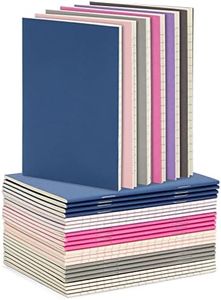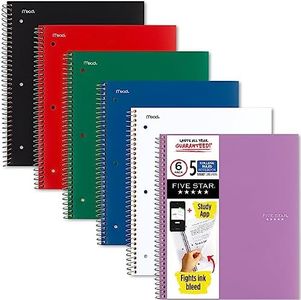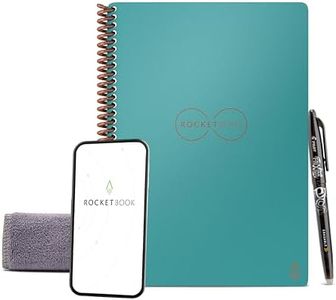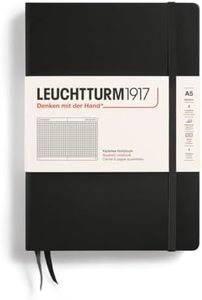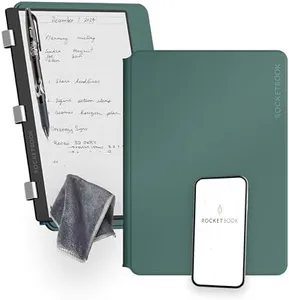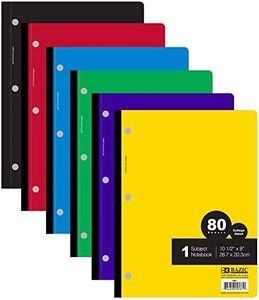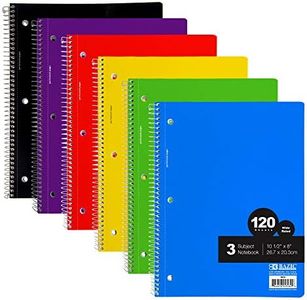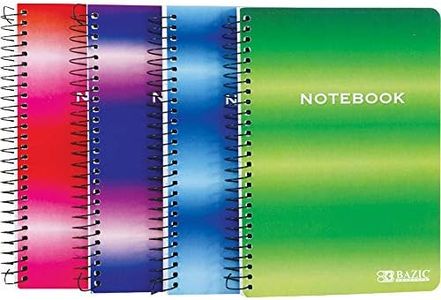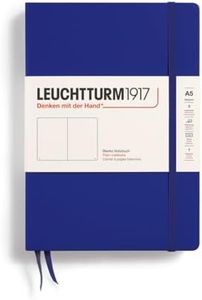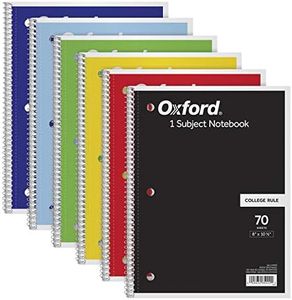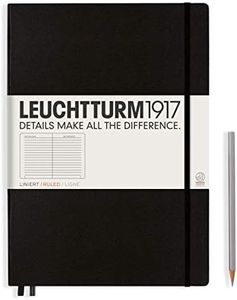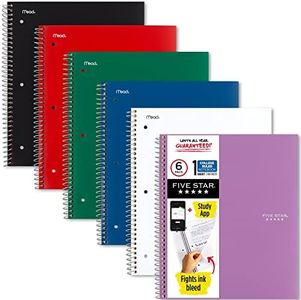10 Best Subject Notebooks 2025 in the United States
Our technology thoroughly searches through the online shopping world, reviewing hundreds of sites. We then process and analyze this information, updating in real-time to bring you the latest top-rated products. This way, you always get the best and most current options available.

Our Top Picks
Winner
Five Star Spiral Notebooks + Study App, 6 Pack, 5 Subject, College Ruled Paper, Fights Ink Bleed, Water Resistant Cover, 8-1/2" x 11", 200 Sheets,Assorted Colors (73793)
Most important from
33549 reviews
The Five Star Spiral Notebook 6-pack is a solid choice for students or anyone needing organized note-taking across multiple subjects. Each notebook is large (8-1/2" x 11") with college ruled pages, offering plenty of writing space on 200 double-sided sheets. The paper is designed to resist ink bleed, which helps keep notes clean and legible. Perforated pages make it easy to tear out sheets neatly when needed. The spiral binding includes a lock feature to prevent snags in clothing or bags, which is a small but useful detail.
The cover is plastic and water resistant, giving decent protection against spills and wear, and the notebooks include sturdy pockets and dividers to keep loose papers organized. The set comes in assorted colors, which can help separate subjects visually. Using certified recyclable paper is a nice eco-friendly touch. One potential drawback is that the cover, while water resistant, is soft rather than rigid, so it might not protect papers as well if you’re carrying the notebook in a crowded bag. Also, at 4.7 pounds for the 6-pack, these notebooks are somewhat heavy to carry all at once.
The integrated app for scanning and creating flashcards is a modern feature that adds value for digital study help but isn’t necessary for everyone. This pack provides durable, well-designed notebooks with useful features for multi-subject organization and note-taking throughout the school year.
Most important from
33549 reviews
Rocketbook Core Reusable Spiral Notebook, Executive Size 6x8.8, Teal - Lined Pages, App-Connected, Erasable, Durable Cover, Ideal for School, Work, and Creative Projects
Most important from
22049 reviews
The Rocketbook Core Reusable Spiral Notebook, Executive Size (6 x 8.8 inches) in teal, stands out with several unique features. Its primary advantage is the ability to write, digitize, erase, and reuse the pages, which is facilitated by the included Pilot Frixion Pen and the Rocketbook app. The app enables you to upload your notes directly to various cloud services, ensuring that your work is always accessible and organized digitally. This functionality is particularly beneficial for students, professionals, and creatives who need a reliable way to store and manage their notes without accumulating physical paper clutter.
The notebook features high-quality lined paper that feels similar to traditional paper, and the pages can be easily cleaned with a damp cloth for repeated use, which makes it an eco-friendly option that helps reduce paper waste. Additionally, the durable, waterproof cardboard cover and spiral binding lend the notebook a robust and portable design, fitting comfortably in most bags and backpacks.
However, the Rocketbook Core has some drawbacks. With only 36 pages, frequent note-takers might find themselves erasing pages more often than they would like. While the paper quality is good for writing, it is specially coated to work with the Pilot Frixion Pen, which may not be suitable for those who prefer using other writing instruments. The app-connected feature, although handy, requires a learning curve and consistent access to smart devices and the internet to fully utilize its capabilities. Despite these limitations, the Rocketbook Core offers a versatile and sustainable solution for managing notes digitally while still enjoying a traditional writing experience.
Most important from
22049 reviews
LEUCHTTURM1917 - Notebook Hardcover Medium A5-251 Numbered Pages for Writing and Journaling (Black, Squared)
Most important from
28992 reviews
The LEUCHTTURM1917 Notebook in medium A5 size is a versatile and practical choice for writing and journaling. With dimensions of 8.25 x 5.75 inches, it is compact enough for easy portability while offering ample space for notes. The notebook features 251 numbered pages of 80g/m² acid-free paper, which is known for its high ink compatibility and minimal bleed-through, making it suitable for various writing instruments.
The squared ruling is helpful for keeping your writing neat and organized, especially for bullet journaling or taking detailed notes. Users appreciate its thread-bound binding, which ensures the notebook stays flat when open, enhancing the ease of writing and reading. The durable faux leather hardcover offers a sophisticated look and protects the pages within.
Additional features like two bookmarks, an elastic closure band, an expandable pocket, and stickers for labeling and archiving add to its functionality and convenience. However, some users may find the 80gsm paper slightly thin for heavier inks or markers. The squared layout may not suit everyone, especially those who prefer lined or blank pages. This notebook is a quality construction with practical features, making it an excellent choice for students, professionals, and anyone who enjoys journaling or note-taking.
Most important from
28992 reviews
Buying Guide for the Best Subject Notebooks
Choosing the right subject notebook can make a significant difference in your organization, note-taking efficiency, and overall productivity. When selecting a notebook, it's important to consider various factors that align with your specific needs and preferences. Here are some key specifications to help you make an informed decision.FAQ
Most Popular Categories Right Now
